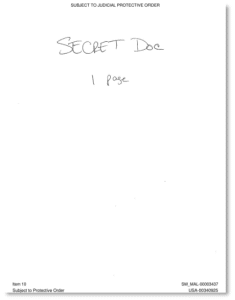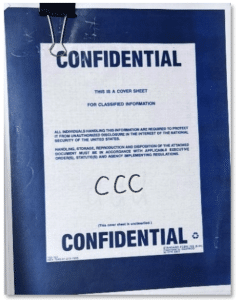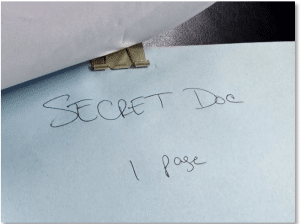As I have noted, the FBI agents who searched Joe Biden’s garage rearranged the contents of the single box which Robert Hur attempted to prove Joe Biden had deliberately curated when they moved the contents from the beat-up box found in the garage to a new one.
When FBI agents repackaged the contents of the ripped garage box into a new box on December 21, 2022, it appears the order of a few of the materials changed slightly. This chapter discusses in detail below two folders that contained marked classified documents about Afghanistan: the manila “Afganastan” folder and the red “Facts First” folder. It appears the “Afganastan” folder was near the “Facts First” folder in the garage box when agents recovered the box, but the precise original location of the “Afganastan” folder at that time is unknown.
Had Hur been able to prove that the contents of this box had been in Biden’s Virginia home when he mentioned classified records to his ghost writer in 2017, and had Hur been able to disprove that that reference wasn’t to other documents Biden had recently returned to the White House or to the letter Biden sent Obama about Afghanistan, and had Hur been able to rule out Biden simply losing track of those files, and had Hur been able to prove that Biden himself and not staffers had been packing and repacking the box, then the order of the box would have been crucial to proving a case against Biden.
Hur hung much of his theory of willful retention on the other documents found with two folders containing classified Afghan documents.
Which is to say, the FBI’s sloppiness would have doomed the case if there were ever a case to bring.
Now, Walt Nauta attorney Stan Woodward is trying to claim the same with regards to the documents seized from Mar-a-Lago, to great effect among right wing propagandists.
He made the claim in a bid to get a delay in filing his CIPA 5 notices (which describe what classified information he’d need to release at trial).
Following defense counsel’s review of the physical boxes, the unclassified scans of the contents of the boxes, and the documents produced in classified discovery, defense counsel has learned that the cross-reference provided by the Special Counsel’s Office does not contain accurate information. For example, Box A-15 is a box seized from the Storage Room and is identified by the FBI as Item 10. The FBI Index indicates that the classified documents removed from the box (and where a cover sheet was inserted in its place) appear in the order listed below. The contents of the unclassified discovery pertaining to Box A-15 begins at USA-00340924, with the first inserted at the second page of the scan, or Bates labeled USA-00340925:
Per the FBI Index, the first purportedly classified document removed from box A-15 was assigned FBI Index code “ccc,” its classified bates begins at 0079, is one page, and bears the classification marking of “CONFIDENTIAL.” For reference, the physical cover sheet from the actual box for document “ccc” appears as depicted in the below image:
To state the obvious, a “Secret” document is not the same as a “Confidential” document. To be sure, a slip sheet in in Box A-15 does match the one scanned as part of unclassified discovery (at USA-00340925):
However, there is no way for defense counsel to know that the slip sheet depicted above actually corresponds with USA-00340925. And the slipsheet labeled “ccc” does not appear for several hundreds of pages later than the FBI Index indicated it would. Defense counsel’s review of these materials calls into question the likelihood that the contents of the physical boxes remains the same as when they were seized by the FBI on August 8, 2022.
Although the Special Counsel’s Office has indicated it will work with defense counsel to accurately produce an index cross-referencing the purported documents with classification markings produced in classified discovery as against the slip sheets now in the physical boxes, that process will take time. Until that process is complete, however, defense counsel cannot know for certain which documents produced in classified discovery were recovered from boxes in the Storage Room nor where those documents were found in the boxes. Accordingly, defense counsel cannot meaningfully identify, pursuant to CIPA § 5(a), the classified information it anticipates being disclosed at trial.
Jack Smith claims this is all a delay tactic invented because Woodward’s other recent delay tactics fell through.
But he concedes, first of all, that after the search team ran out of cover sheets because there were far more classified documents than they imagined, they used hand-written papers to mark where classified records had been found.
The investigative team used classified cover sheets for that purpose, until the FBI ran out because there were so many classified documents, at which point the team began using blank sheets with handwritten notes indicating the classification level of the document(s) seized. The investigative team seized any box that was found to contain documents with classification markings or presidential records.
And then they made sure that each box was handled separately, to ensure that the contents of each individual box remained separate. They failed, however, to keep all the boxes in the same order.
The Government has taken steps to ensure that documents and placeholders remained within the same box as when they were seized, i.e., to prevent any movement of documents from one box to another. The FBI was present when an outside vendor scanned the documents in connection with the now-closed civil case (see, e.g., Trump v. United States, Case No. 22-81294- CIV-CANNON, ECF No. 91 at 2 (requiring the Government to inventory the property seized from Mar-a-Lago); id. at ECF No. 125 at 3 (requiring the Government to “make available to Plaintiff and the Special Master copies of all Seized Materials” in electronic format by October 13, 2022)), and the boxes were kept separate during that process. When the FBI created the inventories, each inventory team worked on a single box at a time, separated from other teams. And during defense counsel’s review, any boxes open at the same time (and any personnel reviewing those boxes) were kept separate from one another. In other words, there is a clear record of which boxes contained classified documents when seized, and this information has long been in the defense’s possession, as discussed infra at 9
4. Location of Classified Documents Within Each Box
Since the boxes were seized and stored, appropriate personnel have had access to the boxes for several reasons, including to comply with orders issued by this Court in the civil proceedings noted above, for investigative purposes, and to facilitate the defendants’ review of the boxes. The inventories and scans created during the civil proceedings were later produced in discovery in this criminal case. Because these inventories and scans were created close in time to the seizure of the documents, they are the best evidence available of the order the documents were in when seized. That said, there are some boxes where the order of items within that box is not the same as in the associated scans.3 There are several possible explanations, including the above-described instances in which the boxes were accessed, as well as the size and shape of certain items in the boxes possibly leading to movement of items. For example, the boxes contain items smaller than standard paper such as index cards, books, and stationary, which shift easily when the boxes are carried, especially because many of the boxes are not full. Regardless of the explanation, as discussed below, where precisely within a box a classified document was stored at Mar-a-Lago does not bear in any way on Nauta’s ability to file a CIPA Section 5 notice.
3 The Government acknowledges that this is inconsistent with what Government counsel previously understood and represented to the Court. See, e.g., 4/12/24 Hearing Tr. at 65 (Government responding to the Court’s question of whether the boxes were “in their original, intact form as seized” by stating “[t]hey are, with one exception; and that is that the classified documents have been removed and placeholders have been put in the documents”).
While I think it ridiculous that the FBI hasn’t managed to keep boxes straight from either Trump or Biden, Smith’s argument — that this is entirely pointless to Nauta’s defense — should be sufficient. Unlike Biden and Trump, Nauta is not alleged to have curated any boxes. He is not accused of willfully retaining classified documents at all.
So the order of documents within the particular boxes is meaningless to his defense (though Trump, who has asked to file a sur-reply piling on, might make great use of this argument if this ever goes to trial).
Plus, it’s worth noting which box Woodward is focused on, A-15. That box happens to have, easily, the biggest number of classified documents in it, 32; a third of the items originally in the box were marked classified. And probably 11 of them, those marked Confidential, have since been declassified and provided in unclassified discovery.
In total, the FBI seized 77 documents with classification markings from the 12 boxes that were seized from the Storage Room, but of those 77 documents, 26 have now been produced in unclassified discovery.
No documents already declassified would be pertinent to a CIPA filing.
In other words, Woodward has selected a box that includes both official and handwritten slip sheets, had no Top Secret documents, but a lot of less classified documents.
Something (he knows from his Jan 6 crime scene cases) a shameless propagandist will wail about.
But not something substantive to Nauta’s case.


